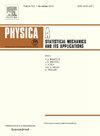Enhancing safety and efficiency of signal intersections: A part-time protected right-turn signal control for straight-right lane in connected environment
IF 2.8
3区 物理与天体物理
Q2 PHYSICS, MULTIDISCIPLINARY
Physica A: Statistical Mechanics and its Applications
Pub Date : 2025-01-18
DOI:10.1016/j.physa.2025.130378
引用次数: 0
Abstract
Straight-right lanes (SRL) are commonly used to improve efficiency of intersections considering urban land dimensions. However, straight-through vehicles (STV) could block right-turn vehicles (RTV) crossing the intersection during the red phase on SRL, resulting in not only low efficiency but also more rear-end conflicts. The advent of connected environments enables urban intersections to collect a large variety of data concerning arriving vehicles and provides an opportunity for real time optimization of signal control plans. This technic could be effectively used to dispose the above dilemma. To this end, the present study proposes a part-time protected right-turn signal control (PPRSC) for SRL to enhance safety and efficiency at intersections. A dynamic queue length (DQL) mechanism is proposed to guide PPRSC. This mechanism is dynamically updated at cycle level using an ant colony optimization (ACO) algorithm which takes expected traffic conflicts and potential waiting time into account. The introduced strategy is tested on a field intersection modeled through the cellular automata (CA) model simulation. Results indicate a decrease in expected traffic conflicts of SRL by 15.3 % and speed fluctuation decreased by 10.88 % for RTV. Besides, average speed of RTV increases by 25.5 %, accompanied by a 60.8 % and 65.7 % reduction in traffic delay and average waiting time, respectively. The findings delineate that the developed PPRSC has great potential to enhance both potential safety and efficiency benefits at signalized intersections.
求助全文
约1分钟内获得全文
求助全文
来源期刊
CiteScore
7.20
自引率
9.10%
发文量
852
审稿时长
6.6 months
期刊介绍:
Physica A: Statistical Mechanics and its Applications
Recognized by the European Physical Society
Physica A publishes research in the field of statistical mechanics and its applications.
Statistical mechanics sets out to explain the behaviour of macroscopic systems by studying the statistical properties of their microscopic constituents.
Applications of the techniques of statistical mechanics are widespread, and include: applications to physical systems such as solids, liquids and gases; applications to chemical and biological systems (colloids, interfaces, complex fluids, polymers and biopolymers, cell physics); and other interdisciplinary applications to for instance biological, economical and sociological systems.

 求助内容:
求助内容: 应助结果提醒方式:
应助结果提醒方式:


